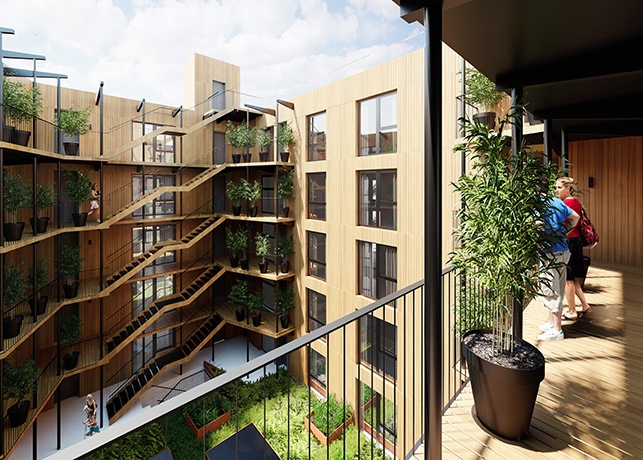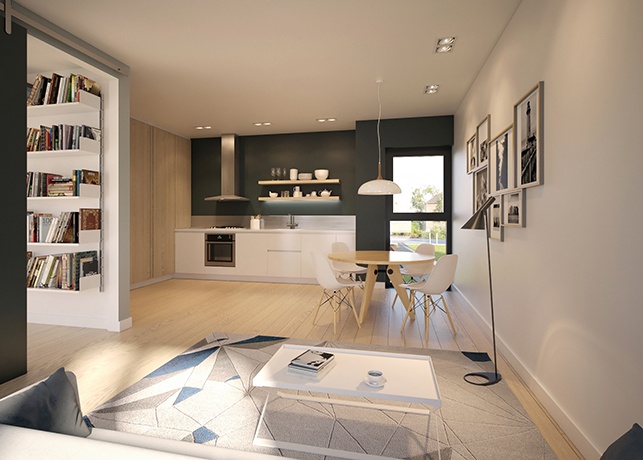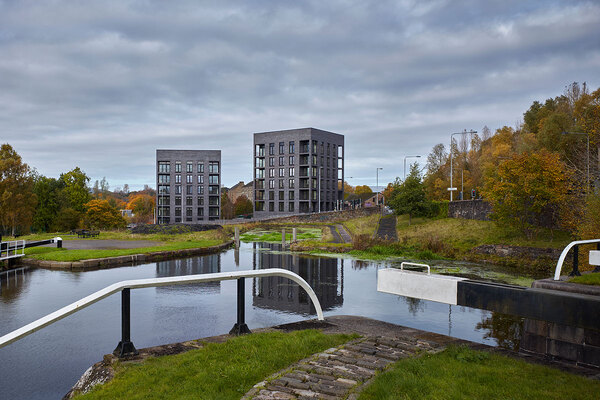Welcome to the space age
As London homes are increasingly being built on smaller footprints, designs that make effective use of space are crucial

Monier Road is aimed at family-sized units
Article written in partnership with:
33-35 Monier Road
Legacy living
Location: Hackney Wick
Planning granted: November 2015
Homes: 45
East London is a key area of regeneration in the capital, and is a big focus for delivering London’s Olympic Legacy. One scheme that is delivering new affordable homes is at Monier Road, Fish Island, a 45-unit scheme in the
borough of Tower Hamlets.
The local area has strong industrial roots, so the landowner Aitch Group was keen to work with an architecture business capable of designing a scheme that could make the most of the available land, while at the same time still managing to meet the requirements of the London Legacy Development Corporation.
Aitch Group selected HWO Architects to deliver the design for the project. The two had previously collaborated on a number of speculative schemes, but Monier Road was the first opportunity in which they worked together from inception to completion.
“We normally work with an architect which has good connections with the local authority and then we would work from there, depending on the type of design we thought was going to be right for that location,” says Laurence Quail, planning manager at Aitch Group.
“The decision to work with them was probably a mixture of the site being close to HWO’s offices and also the style of architecture they’re very strong on.”
Many of the 45 homes in the scheme were designed to be family-sized units, which fits in line with Aitch Group’s strategy to “provide for the widest market that you can do”, according to Mr Quail.
With homes in London increasingly being built with smaller footprints, it was an important consideration for HWO to ensure that the housing for families made the most effective use of space that it could.
“I think what HWO did well was to focus our attention on the fact that you’ve got to provide these units, so why don’t you do it well, not try and squeeze a three-bed unit into something smaller than it should be,” says Mr Quail.
“In that respect, with HWO we’ve had that kind of management that if you’re going to create family units, then make them work and make them successful from the design stage. So, if that was having to have an extra 20, 30, 40, 50, or 100 foot of space, then so be it.”
Work on the site has started in the past three months and the scheme is due for completion in Q4 2017.
“At this stage we’re very happy with the outcome, we look forward to working with HWO and the contractor to make sure the end product is as successful as it can be and that the outcome of the whole project is positive for all,” concludes Mr Quail.
52-54 White Post Lane
Design partnership
Location: Hackney Wick
Planning granted: January 2016
Homes: 55
The decision to tie-up with HWO Architects on a 55-apartment scheme at White Post Lane in Hackney Wick was taken owing to the work that HWO had already achieved on the Monier Road development, says Laurence Quail, planning manager at Aitch Group.
“We selected HWO because of its work on Monier Road - the firm had already started to build up relationships with the local planning authority, the other design consultants, and it obviously knew the area. We instructed the firm when this site was presented to us as well and we worked with HWO in a similar vein to the Monier site,” he says.
The building’s design takes its cue from the area’s historic warehouses, and features simple elevations of pale brick and tall windows with perforated metal screens. Sitting above a number of commercial units are the 55 one, two and three-bedroom apartments, which meet level 4 of the Code for Sustainable Homes.

White Post Lane takes its cue from the local area’s historic warehouses
For Mr Quail, it was important to work with an architect that was able to get Aitch Group’s original vision for design across, which was to draw upon the heavy industry and warehouses that characterised the local area.
“We had to work with the council and HWO to make sure that what we were doing wasn’t just going to be like any other brick building, that it had enough architectural interest to make it stand out,” he comments. “It is directly opposite the route to the train station, so we definitely see it as a major scheme for Hackney Wick.”
The relationship with HWO has been a key factor in the design success of the project, according to Mr Quail.
“[The firm is] not an architect that bangs the drum saying it must be done this way,” he says. “[It is] open to listen to other key team member inputs, particularly the client in terms of making sure we end up with, in effect, the right amount of development that can make it work from our financial point of view.”
180-182 Lordship Lane
Considering space
Location: Stoke Newington
Planning granted: June 2015
Homes: 15
Lordship Lane is a 15-unit development of apartments which has been approved for development in Stoke Newington, Hackney.
When HWO Architects were drafted in to work on the project in 2013, planning consent had already been secured with the local council. Upon reviewing the plans, it was proposed that the internal layouts should be redesigned to make them more generous in size.
This suggestion was supported by Naseem Hakim, director of NFS Investments, the firm behind the project, who realised that the initial design for the scheme could be improved. It was especially important because Mr Hakim had identified that the apartments would be best targeted at families who would need extra space.
“For me, the end user mattered,” he says. “With the first scheme, we solely satisfied planning requirements and a lot of value had been lost in terms of what the end user wanted from these units.”

Lordship Lane focuses on functional use of space
In order to make the flats more spacious, the decision was made to change the design so that they were stacked intelligently floor-by-floor.
“What we looked at was how to best distribute the floor space so that each unit was getting a functional amount of floor space, whereas previously we found that there was a lot of wastage,” says Mr Hakim.
“An end user was actually paying per square foot more than what they needed to. They were getting less floor space and a higher price, so we wanted that distribution to be much more evenly balanced,” he adds.
Mr Hakim says that the project is due to start onsite “within the next two months”, with completion expected approximately a year thereafter.








